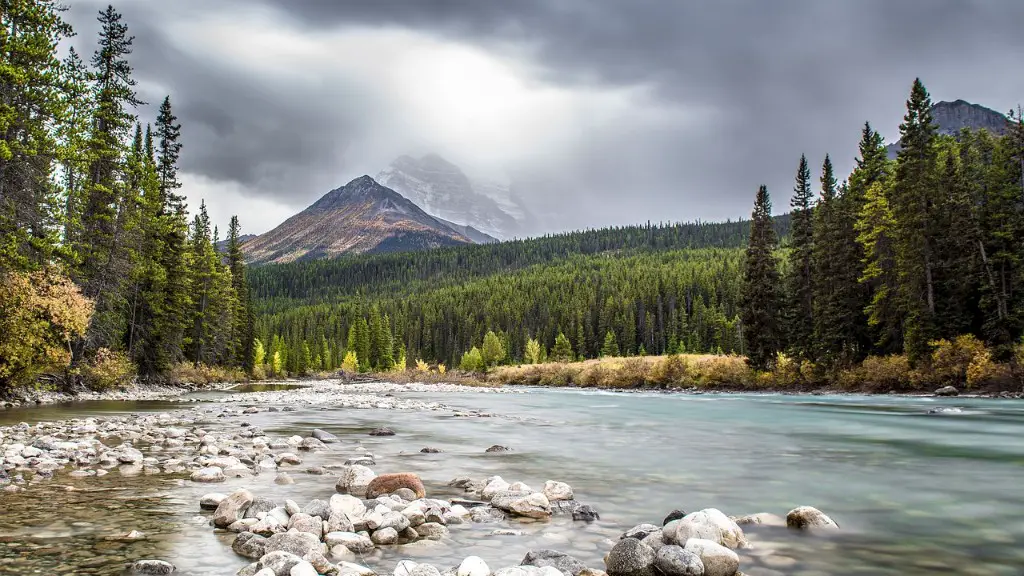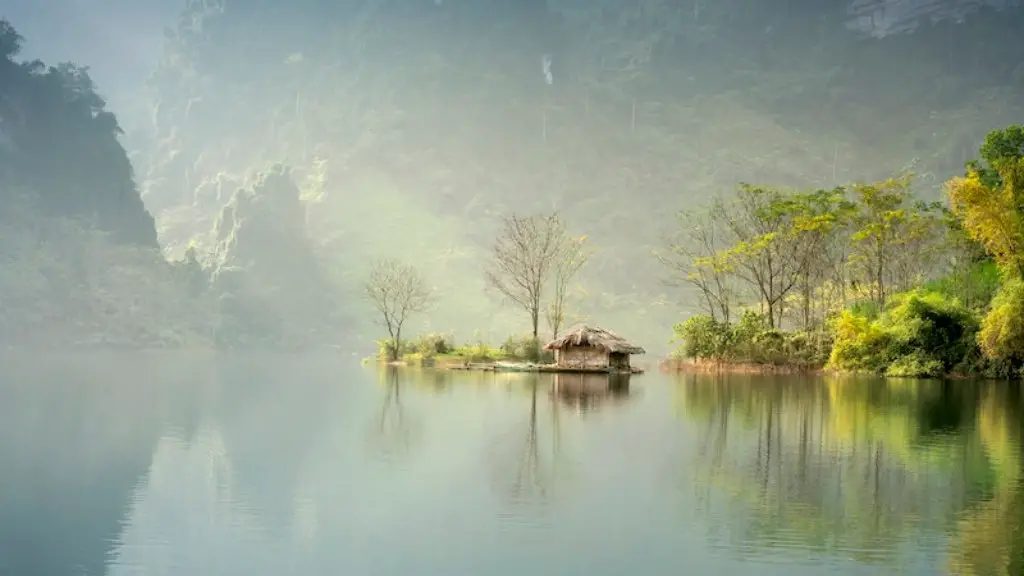The Mississippi River is one of the most iconic rivers in the United States. It stretches for almost 3,000 miles and passes through 10 different states. It is a major source of recreation, fishing, and transportation for the people who live along its banks. The Mississippi River is also home to an abundant array of wildlife, including the American Alligator, American Egret, and many species of fish and birds.
The river begins its journey in Lake Itasca in Northern Minnesota and winds its way south into the Gulf of Mexico. It is believed to be the fourth longest river system in the world, after the Nile, the Amazon and the Yangtze. Early American settlers traveled along the Mississippi to explore the country, giving rise to cities like New Orleans, Memphis, and St Louis.
The Mississippi River is an important source of water for many different industries, including agriculture, hydropower, and recreational activities. In addition, the river plays an important role in the economy, providing jobs for fishermen, barge operators, and boat captains. The sheer size of the river has made it an important trade route for centuries.
The Mississippi River is also a vital part of the environment. It provides an important habitat for many species of wildlife, including the American Alligator, American Egret, and many species of fish and birds. The river also serves to reduce flooding and prevent soil erosion, helping to keep the surrounding area safe and healthy.
Despite its importance, the Mississippi River faces a number of challenges. Pollution is a major problem, particularly in urban areas like Minneapolis and St. Louis. Pollutants like oil and fertilizers can disrupt the river’s delicate ecosystem, resulting in fish kills and algal blooms. Additionally, invasive species like the Asian Carp pose a threat to native wildlife populations.
Conservation efforts are underway to combat these issues. Organizations such as the Mississippi River Resilience Partnership are working hard to reduce pollution, restore habitats, and protect species. The USDA is also investing in watershed restoration and flood prevention projects.
Ultimately, the Mississippi River is an invaluable natural resource. Its size, importance, and beauty make it a sight to behold. It is essential that we do all we can to protect it for future generations.
Economic Impact
The Mississippi River has had a significant impact on the economy for centuries. It has served as an important transportation route for traders, commercial boats, and even early settlers looking to explore the continent. The river has also spurred development in the surrounding areas, resulting in thriving cities like New Orleans and Memphis.
Today, the Mississippi River is still a major economic engine. It provides jobs for fishermen, barge operators, and boat captains, while also providing food, hydropower, and recreation for the people who live near it. In addition, the river is a vital water source for agriculture, helping to feed the country.
The river’s importance is not limited to the United States. It is a major trade route for countries in the Gulf of Mexico, providing a key export route for goods. This has allowed the Mississippi River to become an important source of income for the region.
In recent years, the economic impact of the Mississippi River has only grown as businesses continue to flock to the region. With new businesses and jobs sprouting up, the river has become an even more important part of the local economy.
The economic importance of the Mississippi River makes it a vital resource that needs to be protected and preserved. Without the river, many of these industries would suffer greatly, leading to job losses and economic decline.
Environmental Impact
The Mississippi River is a crucial part of the ecosystem, providing vital habitat for many species of fish and wildlife. It also helps to reduce flooding and prevent soil erosion, keeping the area safe and healthy.
Unfortunately, the river is threatened by a number of environmental problems. Pollution from urban areas and industrial plants is a major concern, resulting in fish kills and algal blooms. Additionally, invasive species like the Asian Carp pose a threat to native wildlife populations.
This means that conservation efforts need to be taken to protect the river. Organizations such as the Mississippi River Resilience Partnership are working hard to reduce pollution and protect species. The USDA is also investing in watershed restoration and flood prevention projects.
It is essential that we do all we can to protect the Mississippi River. Without the river, many of the species that rely on it would be at risk of extinction. In addition, the economic and social benefits that derive from it would be lost.
Cultural Impact
The Mississippi River has played an important role throughout history as a source of inspiration for writers, musicians, and artists. Its winding course has provided the backdrop for countless stories, including literature classics such as Mark Twain’s Adventures of Huckleberry Finn. Musicians, like the blues legend Robert Johnson, have sung about its beauty, while photographers have documented its magic.
The Mississippi River is also a source of fascination for many visitors. People from all over the world come to see what it has to offer. From the picturesque views of nature to the daily hustle and bustle of riverboats, the river provides a glimpse into a world of adventure.
Moreover, the Mississippi River is an important source of pride for many Americans. It has shaped the nation over the centuries, providing an important pathway of exploration and discovery. Many travelers still use the river to explore the sights and sounds of the country, making it an iconic symbol of the United States.
The cultural impact of the Mississippi River is undeniable. It is a source of inspiration, fascination, and pride-all things that make this landmark so truly special.
Tourism Impact
The Mississippi River attracts millions of visitors each year, making it one of the most popular tourist destinations in the United States. Tourists come to explore the area’s abundant wildlife, unique history, and vibrant culture.
The river also provides an important economic boost for surrounding areas. Tourism is a major industry along the Mississippi, providing income for local businesses and jobs for residents. In addition, tourists contribute to the local economy by visiting restaurants and shops, and staying at hotels.
The Mississippi River is also home to some of the world’s most iconic landmarks, such as the Gateway Arch in St. Louis and the French Quarter in New Orleans. These landmarks attract millions of visitors each year, contributing to the economic and cultural vitality of the region.
In addition, the river is a popular destination for outdoor activities like fishing, boating, and swimming. These activities attract nature-lovers and outdoor enthusiasts from all over the world, helping to keep the local area vibrant and thriving.
The Mississippi River is a source of great joy for the millions of visitors it attracts each year. It has captivated the imaginations of people for centuries, and continues to be one of the most popular tourist destinations in the United States.
Conservation Efforts
The Mississippi River is an invaluable resource, providing many economic, social, and environmental benefits. However, protecting the river requires concerted efforts from both the public and private sectors.
The Environmental Protection Agency is working hard to reduce pollution, restore habitats, and protect species. The agency has a number of initiatives in place to reduce runoff from farms and cities, as well as restrict fishing and boating activities in certain areas.
The USDA is also investing in watershed restoration and flood prevention projects. These funds are used to protect the river from erosion and improve water quality. Private organizations, such as the Mississippi River Resilience Partnership, are working hard to raise awareness about the importance of protecting the river.
Conservation efforts are also underway to protect the river’s wildlife. The Wildlife Conservation Society works to protect endangered species, while the Mississippi River Network works to promote sustainable fishing practices.
Ultimately, protecting the Mississippi River is a shared responsibility. It is essential that we all do our part to ensure that the river remains healthy and productive for generations to come.





